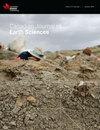加拿大的海洋边界:加拿大为《联合国海洋法公约》绘制扩展大陆架地图的科学遗产
IF 1.6
4区 地球科学
Q3 GEOSCIENCES, MULTIDISCIPLINARY
引用次数: 0
摘要
加拿大于2003年批准了《联合国海洋法公约》。随着这项批准,有义务向联合国提交有关该国扩大大陆架界限的数据和资料;大陆架延伸超过200海里的大陆架部分一组科学家花了13年的时间汇编和收集数据,为划定加拿大最外层海洋界限提供科学证据。该申请书有可能为加拿大在大西洋和北冰洋提供240万平方公里的额外海底陆地,加拿大对这些陆地行使主权权利,以便勘探和开发其自然资源。具体信息,如大陆边缘的构造框架、边缘的地貌、大陆斜坡上的沉积、邻近山脊、隆起和高原的地质性质以及邻近盆地内的沉积物厚度等,都是所需要的基本地球科学信息的例子。本文重点介绍了加拿大大陆边缘的一些部分,以展示这一科学证据,以及如何将其应用于《联合国海洋法公约》。通过这样做,本文展示了加拿大近海土地获得的大量新知识。本文章由计算机程序翻译,如有差异,请以英文原文为准。
Canada’s maritime frontier: the science legacy of Canada’s extended continental shelf mapping for UNCLOS
Canada ratified the United Nations Convention on the Law of the Sea in 2003. With that ratification came an obligation to submit data and information to the United Nations pertaining to the limits of the country’s extended continental shelf; the portion of the juridical continental shelf that extends beyond 200 nautical miles. A team of scientists spent 13 years compiling and acquiring data to provide the scientific evidence to support delineation of Canada’s outermost maritime limits. The submission has the potential to provide Canada with 2.4 million km2 of additional submarine landmass in the Atlantic and the Arctic oceans over which Canada exercises sovereign rights for the purpose of exploring and exploiting its natural resources. Specific information such as the tectonic framework of the continental margin, the geomorphology of the margin, sedimentation on the continental slope, the geologic nature of adjoined ridges, rises, and plateaux, and sediment thickness within adjacent basins are examples of fundamental pieces of geoscientific information needed. This paper highlights a number of segments of Canada’s continental margins to showcase this scientific evidence and how it is applied in the UNCLOS context. In so doing, the paper demonstrates the immensity of new knowledge gained of Canada’s offshore lands.
求助全文
通过发布文献求助,成功后即可免费获取论文全文。
去求助
来源期刊

Canadian Journal of Earth Sciences
地学-地球科学综合
CiteScore
2.80
自引率
7.10%
发文量
66
审稿时长
6-12 weeks
期刊介绍:
The Canadian Journal of Earth Sciences reports current research in climate and environmental geoscience; geoarchaeology and forensic geoscience; geochronology and geochemistry; geophysics; GIS and geomatics; hydrology; mineralogy and petrology; mining and engineering geology; ore deposits and economic geology; paleontology, petroleum geology and basin analysis; physical geography and Quaternary geoscience; planetary geoscience; sedimentology and stratigraphy; soil sciences; and structural geology and tectonics. It also publishes special issues that focus on information and studies about a particular segment of earth sciences.
 求助内容:
求助内容: 应助结果提醒方式:
应助结果提醒方式:


